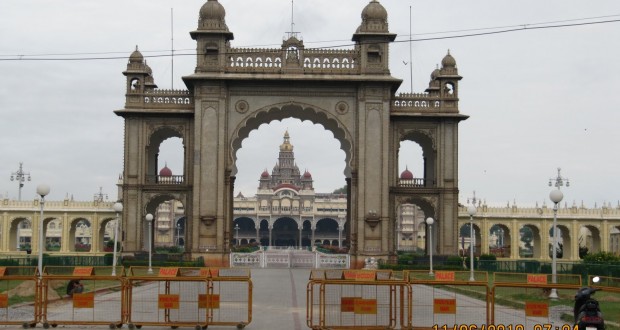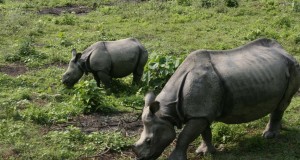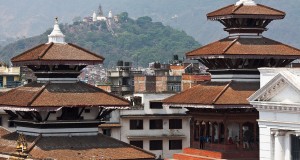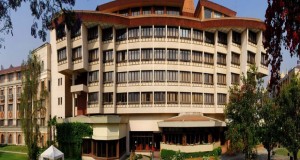Mysore is a small, relaxing place with a lot to see and do in town, and some worthwhile excursion spots (Sriringapatna, Somnathpur, Brindhavan, etc.) just outside it. Orientation is easy; you can walk from one end of the town to the other in 30 minutes. Auto-rickshaws are Rs2.50 per km, and because journeys are so short, you should never have to pay more than Rs10 anywhere. Local buses are useful for out-of-town destinations like Brindhavan, Chamundi, Sriringapatna, Government Silk Weaving Factory etc., and leave from the bus-stand near New Statue Square. For a comprehensive viewing of the many sights, take one of the (good) city conducted tours. Allow a second day’s sightseeing, either to return to certain places you want to see more of, or to do one of the wildlife excursions suggested.
City and Surrounds Tour (conducted tour bus, full-day)
St Philomena’s Church-Art Gallery-Zoo-Maharaja’s Palace-Chamundi Hill-Sriringapatna-Brindhavan Gardens
The first call is generally St Philomena’s Church, at the north of town. 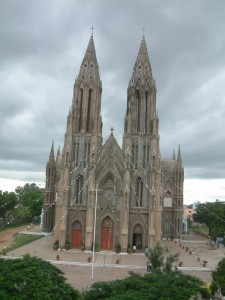 This is one of the largest neo-Gothic style churches in India. Though built in 1931, its lofty grandeur and stained-glass interior are more suggestive of medieval than modern origin. Tour buses rarely stop long here and few of your Indian co-passengers will be Catholics. The Sri Chamarajendra Art Gallery, just off New Statue Square, is of more general interest. It is housed within Jaganmohan Palace, and contains treasures of rare musical instruments, exotic wall decorations, original paintings of Ravi Varma, a couple of beautiful mother-of-pearl inlay sofas, and a marvellous French musical clock (each second marked by a drum beat, toy soldiers march out on parade every hour). Open 8 am-5 pm daily, admission Rs2, no photos allowed.
This is one of the largest neo-Gothic style churches in India. Though built in 1931, its lofty grandeur and stained-glass interior are more suggestive of medieval than modern origin. Tour buses rarely stop long here and few of your Indian co-passengers will be Catholics. The Sri Chamarajendra Art Gallery, just off New Statue Square, is of more general interest. It is housed within Jaganmohan Palace, and contains treasures of rare musical instruments, exotic wall decorations, original paintings of Ravi Varma, a couple of beautiful mother-of-pearl inlay sofas, and a marvellous French musical clock (each second marked by a drum beat, toy soldiers march out on parade every hour). Open 8 am-5 pm daily, admission Rs2, no photos allowed.
Mysore’s Zoological Gardens, Lalitha Palace Rd (1 km; 2/3 mile east of the central bus-stand) are, apart from those of Hyderabad, the best in India. Over 1500 varieties of animals and birds live here, in near-natural surrounds. The brief tour stop is insufficient to see half what’s available. Return on a separate occasion for a com- prehensive visit (come early, when the big cats are awake). Open 8.30 am-5.30 pm daily, admission Rs2.
The Indo-Saracenic Maharajah’s Palace in the town centre is Mysore’s main attraction and the entrance by South Gate only. Built over a period of 15 years (1897-1912) after the old wooden palace was razed by fire, this imposing structure, a gleaming profusion of domes, turrets, archways and colonnades, was designed by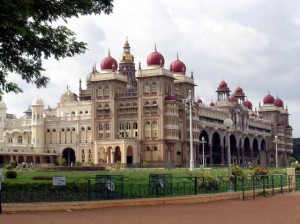 the English architect Henry Irwin, with workmanship by local artists (the Hoysalastyle wall decorations are especially fine). An immense structure, it measures 74.5 m long, 44 m high, 47.5 m wide. The interior is a Pandora’s box of treasures: a Durbar Hall with jewel-studded throne, mosaic marble floors, crystal furniture, stained-glass domed ceiling (a miracle of art and design), hammered silver doors opening onto sumptuously furnished apartments, mirror-spangled pleasure rooms and a lovely portrait gallery. Hugely extravagant, but great fun. Open 10 am to 5.30 pm daily.
the English architect Henry Irwin, with workmanship by local artists (the Hoysalastyle wall decorations are especially fine). An immense structure, it measures 74.5 m long, 44 m high, 47.5 m wide. The interior is a Pandora’s box of treasures: a Durbar Hall with jewel-studded throne, mosaic marble floors, crystal furniture, stained-glass domed ceiling (a miracle of art and design), hammered silver doors opening onto sumptuously furnished apartments, mirror-spangled pleasure rooms and a lovely portrait gallery. Hugely extravagant, but great fun. Open 10 am to 5.30 pm daily.
Admission (Rs2 for each section) includes free guide service (tours every hour from 10 am). Cameras and shoes must be left at the entrance, unless you get permission from the Museum Director (office near ticket desk) to take photos. If you’re in town on a Sunday evening (7 to 9 pm), return to the Palace to see it brilliantly illuminated with thousands of tiny bulbs. The atmosphere is amazing: teeming crowds of picnicking tourists, balloons, toys, snacks and food, fruit and sweetmeats, Indian music wailing out of loudspeakers, and of course the glittering backdrop of the fairytale palace.
Chamundi Hill (4 km; 2 1/2 miles) out of Mysore, at an altitude of 1072m, is a popular beauty spot with panoramic views and elegant parks. Once a royal summer resort, the hill is now a major pilgrimage and tourist centre.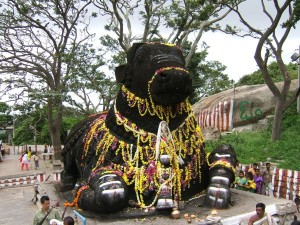 At the top, visit the 12th-century Sri Chamundeswari Temple, built in the southern Dravidian style with a distinctive gopuram. Within, there’s an interesting pillar with silver panels depicting Ganesh, Nandi, and Shiva’s trident, facing into the solid-gold Chamunda figure. If visiting independently, note that the temple is only open from 9 am to noon, and 5 to 9 pm. In the open courtyard below it, you’ll find the Mahishasura Statue (a giant technicolor pirate) erected in memory of Chamunda’s slain demon. Behind it is the small Godly Museum. A third of the way down Chamundi Hill is the huge monolith Nandi Bull, the third-largest (49 m high) in India. To see Chamundi properly return by local bus and make the invigorating 1000-step pilgrims’ climb. Out at Somnathpur (45 km; 28 miles from Mysore) there’s one of the most beautiful temples in the world. Built in 1268, dedicated to Keshava, it is one of the three great Hoysala Temples of Karnataka. Covered with beautiful carvings portraying various scenes from the Ramayana and other epics, also numerous fascinating depictions of Hoysala life and times—the temple is especially notable for the six horizontal friezes running round its baseline. Open 9 am-5 pm daily. The Rsl admission includes a free guide service. There’s a tourist canteen cum rest house in Somnathpur, should you wish to stay overnight.
At the top, visit the 12th-century Sri Chamundeswari Temple, built in the southern Dravidian style with a distinctive gopuram. Within, there’s an interesting pillar with silver panels depicting Ganesh, Nandi, and Shiva’s trident, facing into the solid-gold Chamunda figure. If visiting independently, note that the temple is only open from 9 am to noon, and 5 to 9 pm. In the open courtyard below it, you’ll find the Mahishasura Statue (a giant technicolor pirate) erected in memory of Chamunda’s slain demon. Behind it is the small Godly Museum. A third of the way down Chamundi Hill is the huge monolith Nandi Bull, the third-largest (49 m high) in India. To see Chamundi properly return by local bus and make the invigorating 1000-step pilgrims’ climb. Out at Somnathpur (45 km; 28 miles from Mysore) there’s one of the most beautiful temples in the world. Built in 1268, dedicated to Keshava, it is one of the three great Hoysala Temples of Karnataka. Covered with beautiful carvings portraying various scenes from the Ramayana and other epics, also numerous fascinating depictions of Hoysala life and times—the temple is especially notable for the six horizontal friezes running round its baseline. Open 9 am-5 pm daily. The Rsl admission includes a free guide service. There’s a tourist canteen cum rest house in Somnathpur, should you wish to stay overnight.
The next stop is the ruins of Sriringapatna, 16 km (10 miles) out of Mysore. From this small island fortress-town straddling the river Cauvery came the two brilliant Muslim leaders Hyder Ali and his son Tipu Sultan, who ruled a powerful empire till comprising much of southern India for 40 years. Tipu Sultan, the ‘Tiger of Mysore’, i became the most dreaded foe of the British in the South, and inflicted two punishing defeats on the forces of the East India Company before at last being overcome in 1799.
His beautiful fort was destroyed, but the elegant Summer Palace (Maria Daulat Bagh)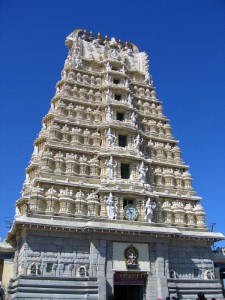 remains intact. Set in beautiful gardens, approached via a corridor of sculpted trees, the stylish lime-green palace built in 1784 is mainly constructed of wood. The interior is beautifully painted in black, red and gold and features attractive floral decorations and various portraits of Tipu’s contemporaries. Amongst the murals depicting battle scenes, there is one commemorating Tipu and Hyder Ali’s victory at Polilur, the plaque beneath mocking the Deccan forces (who arrived too late to help the British) with the taunt ‘they came like a boar and fled like a cow’. The superb little museum upstairs has a fascinating collection of engravings, family ink drawings, coins and prints illustrating Tipu’s life and times, plus a number of his belongings. The palace is open 9 am-5 pm daily, admission Rs0.50. There are good guides for hire.
remains intact. Set in beautiful gardens, approached via a corridor of sculpted trees, the stylish lime-green palace built in 1784 is mainly constructed of wood. The interior is beautifully painted in black, red and gold and features attractive floral decorations and various portraits of Tipu’s contemporaries. Amongst the murals depicting battle scenes, there is one commemorating Tipu and Hyder Ali’s victory at Polilur, the plaque beneath mocking the Deccan forces (who arrived too late to help the British) with the taunt ‘they came like a boar and fled like a cow’. The superb little museum upstairs has a fascinating collection of engravings, family ink drawings, coins and prints illustrating Tipu’s life and times, plus a number of his belongings. The palace is open 9 am-5 pm daily, admission Rs0.50. There are good guides for hire.
Beyond the Palace there’s Tipu Sultan’s mosque, the large and imposing Jami Masjid, notable for its tall minarets; also the Gumbaz, burial place of Tipu and Hyder Ali. Walking up to the extensive Fort ruins, note the small plaque, on your right, marking the spot where Tipu Sultan died in combat. Also, see the Sri Ranganathaswamy Temple, one of the oldest Dravidian temples in Karnataka, AD 894. A prominent white blockstone structure, supported by hundreds of monolith pillars, it houses a massive Vishnu reclining on a serpent and a soaring brass prayer column. The ride back from Sriringapatna to Mysore is very picturesque, a continuous vista of palm-groves, rice paddies and sugar-cane plantations. For this journey alone, the bus tour is worthwhile. If you wish to stay at Sriringapatna, by the way, there are cheap riverside cottages for rent at the Hotel Mayura River View (tel 114).
Last stop of the day is at the fabulous Brindhavan Gardens. Situated 19 km (12 miles) north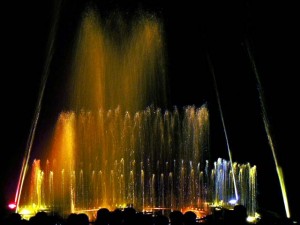 of Mysore, these are among the best known of Karnataka’s attractions. Beautifully terraced below the recent (1937) Krishnarajasagar Dam, Brindhavan’s ornamental gardens take their name from an original series in Mathura, south of Delhi. Taking as their theme the pastoral frolics of Krishna with his 16 000 gopis (handmaidens), they are of enormous popularity among young Indian couples. In high season (April/May) up to 400 tour buses per day swarm up here. Weekends are also excessively busy. Arriving here around dusk, you’ll have time to view the landscaped lawns, rose gardens, flower bowers and conifers in the (vast) southern section before the mass exodus starts via the central boating lake (Rs3 boat trips) to see the pretty musical ‘dancing fountains’. These are illuminated each evening from 7 to 8 pm Monday to Friday, 7 to 9 pm Saturday to Sunday. So are the gardens, which are transformed into a colourful fairyland of cascading fountains and twinkling lights. The walk back to the tour bus is delightful. For overnight stay, choose between the ex-palace Krishnaraj Sagar Hotel (tel Beluga 22) with rooms from Rs325 single, Rs450 double or the cheaper KSTDC Tourist Home (tel Beluga 52) with single and double rooms at Rs90 and Rsl25. Both offer fine views, but are often full. One sight rarely seen in Mysore is the marvellous Rail Museum in Krishnarajasagar Rd, just above the railway station itself. Almost as good as the one in Delhi, it houses antique engines, rolling stock, the Maharani’s coach and a joyride mini-train. Open 9 am-5 pm daily, except Monday.
of Mysore, these are among the best known of Karnataka’s attractions. Beautifully terraced below the recent (1937) Krishnarajasagar Dam, Brindhavan’s ornamental gardens take their name from an original series in Mathura, south of Delhi. Taking as their theme the pastoral frolics of Krishna with his 16 000 gopis (handmaidens), they are of enormous popularity among young Indian couples. In high season (April/May) up to 400 tour buses per day swarm up here. Weekends are also excessively busy. Arriving here around dusk, you’ll have time to view the landscaped lawns, rose gardens, flower bowers and conifers in the (vast) southern section before the mass exodus starts via the central boating lake (Rs3 boat trips) to see the pretty musical ‘dancing fountains’. These are illuminated each evening from 7 to 8 pm Monday to Friday, 7 to 9 pm Saturday to Sunday. So are the gardens, which are transformed into a colourful fairyland of cascading fountains and twinkling lights. The walk back to the tour bus is delightful. For overnight stay, choose between the ex-palace Krishnaraj Sagar Hotel (tel Beluga 22) with rooms from Rs325 single, Rs450 double or the cheaper KSTDC Tourist Home (tel Beluga 52) with single and double rooms at Rs90 and Rsl25. Both offer fine views, but are often full. One sight rarely seen in Mysore is the marvellous Rail Museum in Krishnarajasagar Rd, just above the railway station itself. Almost as good as the one in Delhi, it houses antique engines, rolling stock, the Maharani’s coach and a joyride mini-train. Open 9 am-5 pm daily, except Monday.

